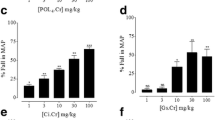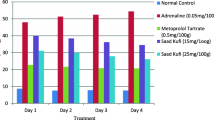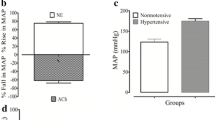Abstract
Orobanche egyptiaca, a parasitic herb, when investigated chemically, proved to contain alkaloid (S), tannins, organic acids, reducing sugars, glucosides, resins and unsaturated substances. The aqueous extract stimulated the contractions of frog's heart and rat's intestine, but inhibited uterine contractions in rats, also it produced marked diuresis in rabbits. The alkaloid residue proved to possess a powerful hypotensive effect through direct effect on arterial wall and was of very low toxicity. Accordingly, it can be applied in the treatment of hypertensive patients specially in cases complicated by heart failure. Further studies are on hands to elucidate its effect on hypertensive patients.
Zusammenfassung
Orobanche egyptiaca, eine parasitisch lebende Pflanze, enthält aufgrund der chemischen Analyse Alkaloide, Tannine, organische Säuren, reduzierende Zucker, Glycoside, Harze und ungesättigte Verbindungen. Der wäßrige Extrakt stimuliert die Kontraktion des Froschherzens und des Rattendarms, hemmt jedoch die Uterus-Kontraktion der Ratten und fördert die Diurese bei Kaninchen.
Der Alkaloidanteil besitzt eine starke Blutdruck-senkende Aktivität durch direkte Wirkung auf die Arterienwand und weist eine sehr geringe Toxizität auf. Folglich kann es bei Patienten mit Bluthochdruck angewendet werden, speziell bei Komplikationen mit Herzschwäche.
Z.Zt. laufen weitere Versuche, um die Wirkung auf Patienten mit Bluthochdruck zu erforschen.
Similar content being viewed by others
References
Bein, H. J. (1953) Zur pharmacologie des Reserpin, eines neuen Alkaloids aus Rauwolfia Serpentina Benth,Experientia (Basel) 9:107.
Burn, J. H. (1952) Langendorff's method for perfusion of the isolated heart of rabbit. Practical Pharmacology, First print, p. 25.
Goldblatt, H., Lynch, J., Hanzal, R. F. & Summerville, W. W. (1934) Studies on experimental hypertension. 1. The production of persistent elevation of systolic blood pressure by means of renal ischaemia.J. Exp. Med. 59:347.
Jackson, D. E. (1917) Experimental pharmacology, p. 99.
Krayer, O. (1958) Veratrum alkaloids. In: Drill, V. A. (ed) Pharmacology in medicine 2nd. ed. McGraw-Hill Book Co., New York, p. 515.
Krayer, O. & Acheson, G. H. (1946) The pharmacology of veratrum alkaloids.Physiol. Rev. 26:383.
Plummer, A. J., Trapold, J. H., Schneider, J. A., Barrett, W. & Earl, A. E. (1954)Ann. New York Acad. Sci., 59:8.
Sharaf, A., Shihata, I. M. & Fouad, K. (1955) Nembutal rectal anaesthesia.Vet. Med. J. 2:83.
Syme, J. (1918) Physiol. S 2. Proc., 46.
Author information
Authors and Affiliations
Rights and permissions
About this article
Cite this article
Sharaf, A., Youssef, M. Pharmacologic investigation on Orobanche egyptiaca with a special study on its hypotensive action. Plant Food Hum Nutr 20, 255–269 (1971). https://doi.org/10.1007/BF01104902
Issue Date:
DOI: https://doi.org/10.1007/BF01104902




